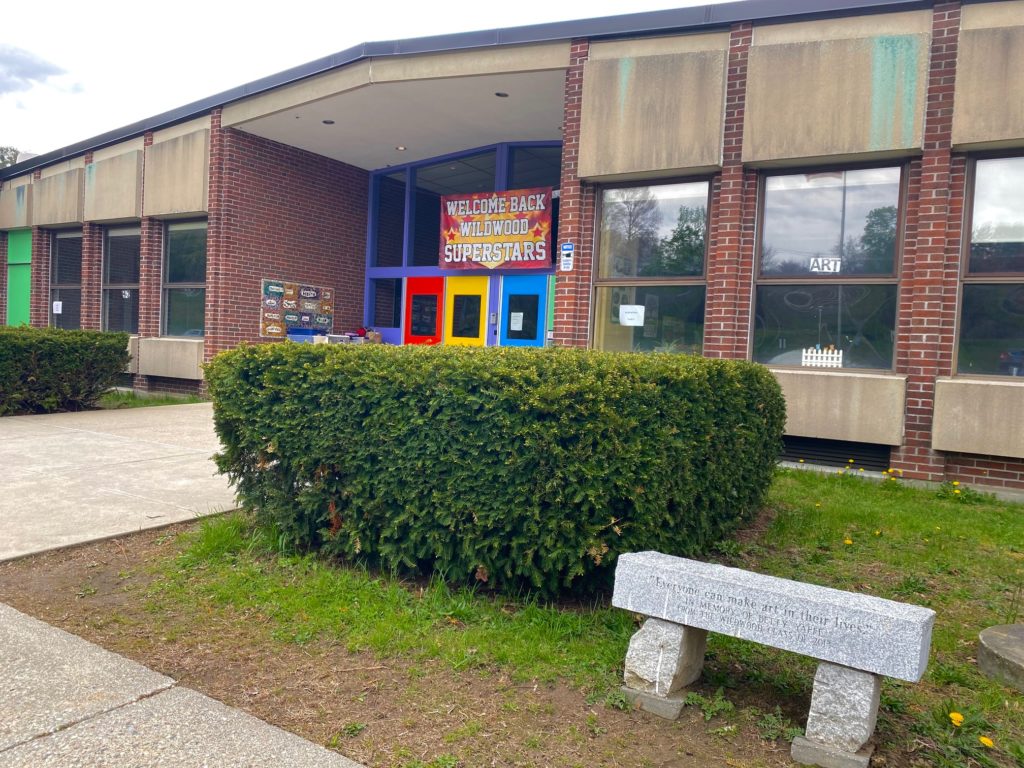Issues & Analysis: The Current School Building Project: Smaller, Greener, Better

Wildwood School. Photo: Toni Cunningham
This column appeared previously in The Amherst Bulletin.
Many in town will recall the bruising battle of 2016/2017, when parents and community members were at loggerheads on whether to move forward with the school building plan proposed at that time. In the end, resident support fell short of the required two thirds threshold, and the project was rejected.
The District’s first try to get back into the state grant program was unsuccessful, reportedly because the state felt Amherst “wasn’t ready,” and indeed that was true as little progress had been made in the intervening period toward finding consensus. Once a commitment was made to cap the school size at 600 students and keep grades kindergarten through five together, Amherst was invited back in.
While some residents still hold onto resentment and anger about the rejection of the last plan, it is important to note how different — and arguably better in every respect — this new plan will be.
The two primary sticking points last time were school size and grade span. Parents and educators alike balked at putting 750 elementary students in one building, and separating the children in kindergarten and first grade (at Crocker Farm) from their siblings and neighbors in grades two through six (in the new building at Wildwood). The cohort size in both buildings would have increased dramatically from two or three classes per grade to about eight or nine.
The new plan will likely result in a consolidation of Wildwood and Fort River into a 575-student school for grades kindergarten through five (if the School Committee approves the move of Amherst sixth graders to the middle school), to be located at either the Fort River or Wildwood site. At the consolidated school, at least two of the five classes in each grade will be in the Spanish-English dual-language program called “Caminantes,” while K-5 enrollment at Crocker Farm will increase to about 375 students, in three classes per grade.
Had the 2016 plan moved forward, it is highly-unlikely there would be a Caminantes program, which arose out of a working group subsequent to the previous failed project. The 2016 plan lacked pedagogical innovation, and in fact the decision to split the grades between first and second ran counter to educational practice, which defines early childhood as pre-kindergarten through second grade. It is yet to be determined where the preschool program would be located under the consolidation plan; keeping it at Crocker Farm would likely require a building expansion.
In addition to a smaller school that keeps grades K-5 together, the new building will comply with the Zero Energy Town Buildings Bylaw, passed in 2018. This means it will be fossil-fuel-free and highly energy-efficient, with sufficient on-site renewables to generate all the building’s energy needs. Since it will exceed the energy code, it will be eligible for increased reimbursement from the state. Contrast this with the 2016 plan which would have had two oil-fired boilers and a design that was only minimally energy efficient. Indeed, it is surprising that some environmentalists in town supported it at all.
Transportation, too, will be much-improved in the new plan. The last project required four additional buses traveling an estimated 120 more miles every day, resulting in increased greenhouse gas emissions and longer journeys for many children. Some proponents had predicted the electric bus fleet would be expanded by now but in fact the district still has only one electric bus and continues to purchase diesel buses when replacements fall due.
Lastly, despite the fact that four years have passed and construction costs increase annually, this project may actually cost taxpayers less than the previous plan. There are a number of reasons for this: it will be a smaller building; the greener design will qualify for higher reimbursement from the state; choosing addition/renovation could cost significantly less than all-new construction; and interest rates are lower than they were in 2016. The drop in interest rates alone could mean savings of up to $10 million over the life of the loan, and in estimates extrapolated from the Fort River study, even when accounting for the upfront cost of meeting the Zero Energy Bylaw, the town share of the new project (after state reimbursement) could be less than the $33 million estimated in 2016.
For potentially a lower cost to taxpayers, and while helping the town meet its ambitious energy goals, the town will get the school it wants and needs: a smaller enrollment, longer grade span, and a greener building to boot.
For more on the status of the elementary school building project, see here, here, and here.
Toni Cunningham is an avid follower of town government, mother of two girls, Irish, a data junkie, and former Town Meeting Member from Precinct 3.

Thank you for this clear and thoughtful analysis.